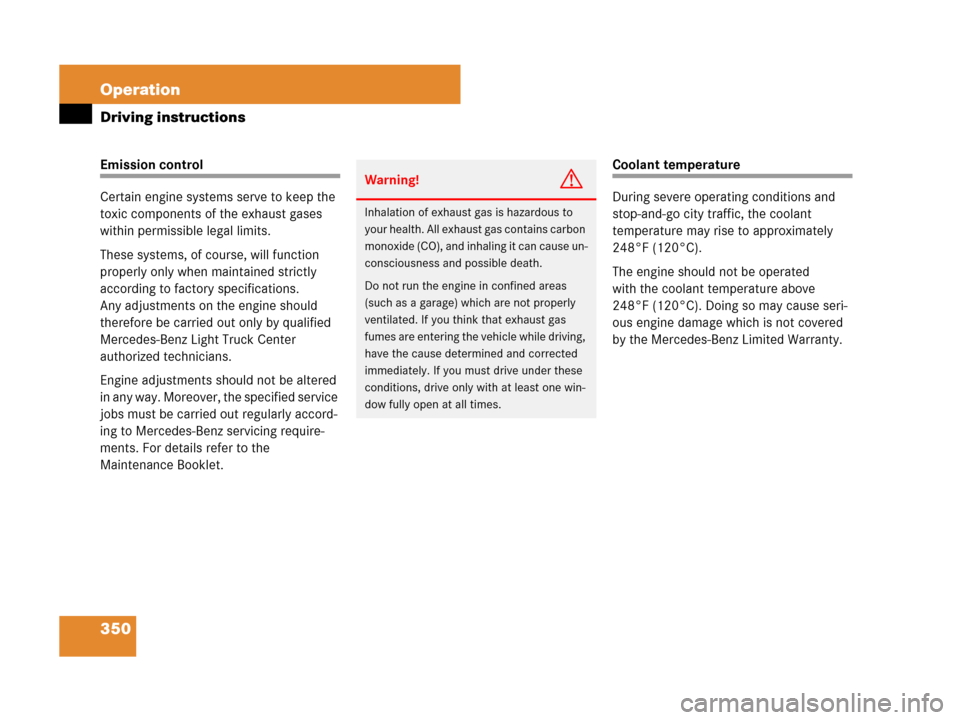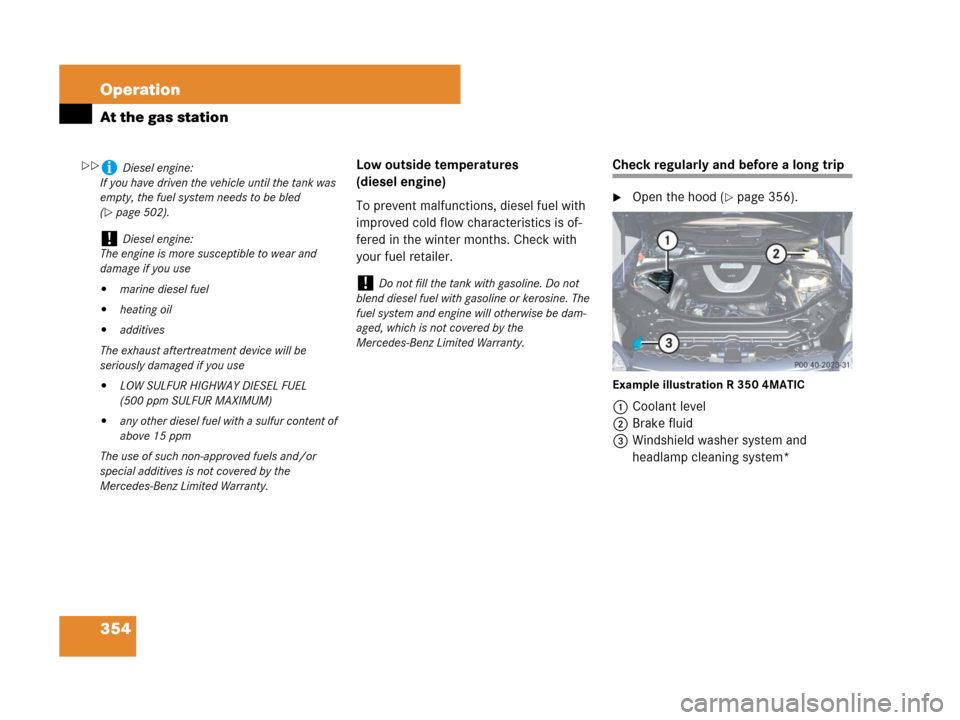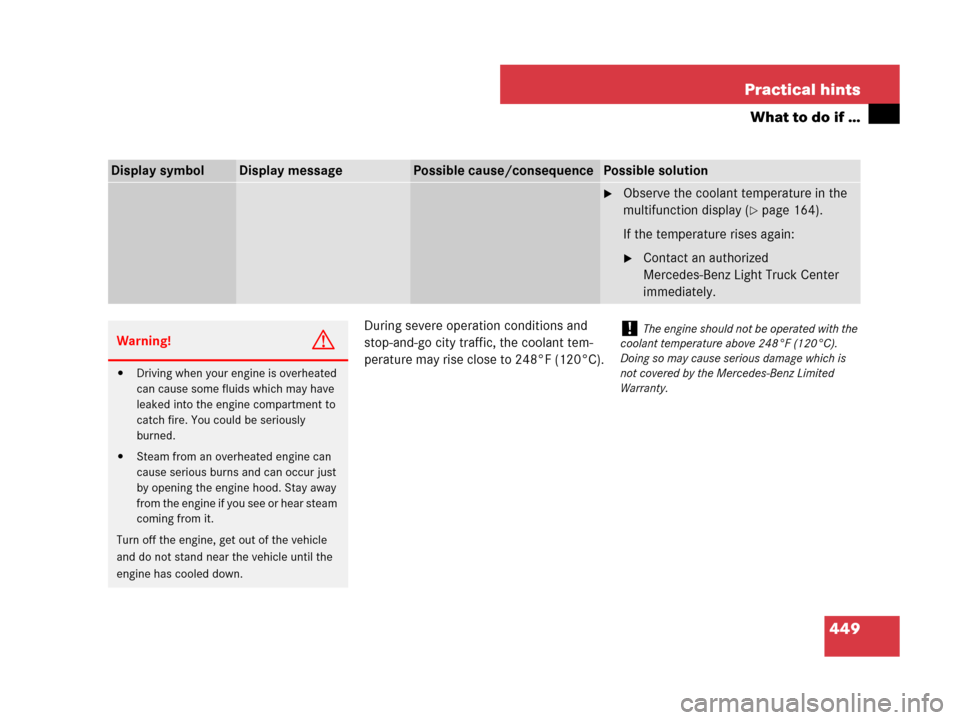Page 351 of 569

350 Operation
Driving instructions
Emission control
Certain engine systems serve to keep the
toxic components of the exhaust gases
within permissible legal limits.
These systems, of course, will function
properly only when maintained strictly
according to factory specifications.
Any adjustments on the engine should
therefore be carried out only by qualified
Mercedes-Benz Light Truck Center
authorized technicians.
Engine adjustments should not be altered
in any way. Moreover, the specified service
jobs must be carried out regularly accord-
ing to Mercedes-Benz servicing require-
ments. For details refer to the
Maintenance Booklet.Coolant temperature
During severe operating conditions and
stop-and-go city traffic, the coolant
temperature may rise to approximately
248°F (120°C).
The engine should not be operated
with the coolant temperature above
248°F (120°C). Doing so may cause seri-
ous engine damage which is not covered
by the Mercedes-Benz Limited Warranty.
Warning!G
Inhalation of exhaust gas is hazardous to
your health. All exhaust gas contains carbon
monoxide (CO), and inhaling it can cause un-
consciousness and possible death.
Do not run the engine in confined areas
(such as a garage) which are not properly
ventilated. If you think that exhaust gas
fumes are entering the vehicle while driving,
have the cause determined and corrected
immediately. If you must drive under these
conditions, drive only with at least one win-
dow fully open at all times.
Page 355 of 569

354 Operation
At the gas station
Low outside temperatures
(diesel engine)
To prevent malfunctions, diesel fuel with
improved cold flow characteristics is of-
fered in the winter months. Check with
your fuel retailer.Check regularly and before a long trip
�Open the hood (�page 356).
Example illustration R 350 4MATIC
1Coolant level
2Brake fluid
3Windshield washer system and
headlamp cleaning system*
iDiesel engine:
If you have driven the vehicle until the tank was
empty, the fuel system needs to be bled
(
�page 502).
!Diesel engine:
The engine is more susceptible to wear and
damage if you use
�marine diesel fuel
�heating oil
�additives
The exhaust aftertreatment device will be
seriously damaged if you use
�LOW SULFUR HIGHWAY DIESEL FUEL
(500 ppm SULFUR MAXIMUM)
�any other diesel fuel with a sulfur content of
above 15 ppm
The use of such non-approved fuels and/or
special additives is not covered by the
Mercedes-Benz Limited Warranty.
!Do not fill the tank with gasoline. Do not
blend diesel fuel with gasoline or kerosine. The
fuel system and engine will otherwise be dam-
aged, which is not covered by the
Mercedes-Benz Limited Warranty.
��
Page 356 of 569

355 Operation
At the gas station
Engine oil level
For more information on engine oil, see
“Engine oil” (
�page 358).
Coolant
For normal replenishing, use water (pota-
ble water quality). For more information,
see “Coolant level” (
�page 360) and
“Fuels, coolants, lubricants, etc.”
(
�page 536).
Brake fluidWindshield/rear window washer
system and headlamp cleaning
system*
For more information on refilling the wash-
er reservoir, see “Windshield/rear window
washer system and headlamp cleaning
system*” (
�page 362).
Vehicle lighting
Check function and cleanliness. For infor-
mation on replacing light bulbs, see “Re-
placing bulbs” (
�page 480).
For more information, see “Exterior lamp
switch” (
�page 143).
Tire inflation pressure
For more information, see “Checking tire
inflation pressure” (
�page 373).
!If you find that the brake fluid in the brake
fluid reservoir has fallen to the minimum mark or
below, have the brake system checked for brake
pad thickness and leaks immediately. Contact an
authorized Mercedes-Benz Light Truck Center
immediately. Do not add brake fluid as this will
not solve the problem. For more information, see
“Brake fluid” (
�page 539).
Page 357 of 569

356 Operation
Engine compartment
Hood
Opening
Warning!G
Do not pull the release lever while the vehi-
cle is in motion. Otherwise the hood could
be forced open by passing air flow.
This could cause the hood to come loose
and injure you and/or others.
Warning!G
If you see flames or smoke coming from the
engine compartment, or if the coolant tem-
perature display indicates that the engine is
overheated, do not open the hood. Move
away from the vehicle and do not open the
hood until the engine has cooled.
If necessary, call the fire department.
Warning!G
You could be injured when the hood is open
– even when the engine is turned off.
Parts of the engine can become very hot. To
prevent burns, let the engine cool of com-
pletely before touching any components on
the vehicle. Comply with all relevant safety
precautions.
Warning!G
To help prevent personal injury, stay clear of
moving parts when the hood is open and the
engine is running.
The radiator fan may continue to run for
approximately 30 seconds or may even
restart after the engine has been turned off.
Stay clear of fan blades.
Warning!G
Vehicles with gasoline engine:
The engine is equipped with a transistor-
ized ignition system. Because of the high
voltage it is dangerous to touch any compo-
nents (ignition coils, spark plug sockets,
diagnostic socket) of the ignition system
�with the engine running
�while starting the engine
�if ignition is “on” and the engine is
turned manually
Page 361 of 569

360 Operation
Engine compartment
Be careful not to spill any oil when adding.
Avoid environmental damage caused by oil
entering the ground or water.
�Screw filler cap1 back on filler neck.
For more information on engine oil, see
“Technical data” section (
�page 536) and
(
�page 538).
Transmission fluid level
The transmission fluid level does not need
to be checked. If you notice transmission
fluid loss or gear shifting malfunctions,
have an authorized Mercedes-Benz Light
Truck Center check the automatic trans-
mission.Coolant level
The engine coolant is a mixture of water
and anticorrosion/antifreeze. To check
the coolant level, the vehicle must be
parked on level ground.
!Excess oil must be siphoned or drained off.
It could cause damage to the engine or
emission control system not covered by the
Mercedes-Benz Limited Warranty.
Warning!G
In order to avoid any potentially serious
burns:
�Use extreme caution when opening the
hood if there are any signs of steam or
coolant leaking from the cooling system,
or if the coolant temperature display
indicates that the coolant is overheated.
�Do not remove pressure cap on coolant
reservoir if coolant temperature is
above 158°F (70°C). Allow engine to
cool down before removing cap. The
coolant reservoir contains hot fluid and
is under pressure.
�Using a rag, slowly open the cap approx-
imately 1/2turn to relieve excess pres-
sure. If opened immediately, scalding
��
Page 362 of 569
361 Operation
Engine compartment
The coolant expansion tank is located on
the passenger side of the engine compart-
ment.
1Cap
2Coolant expansion tank
3Indicator wall
4Coolant level
�Using a rag, turn cap 1 slowly approx-
imately one half turn counterclockwise
to release any excess pressure.
�Continue turning cap 1 counterclock-
wise and remove it.
Coolant level 4 is correct if the level:
�for cold coolant: reaches the top of
indicator wall 3 visible through the
filling opening
�for warm coolant: is approximately
0.6 in (1.5 cm) higher
�Add coolant as required.
�Replace and tighten cap 1.
For more information on coolant, see
“Coolants” (
�page 541).
hot fluid and steam will be blown out un-
der pressure.
�Do not spill antifreeze on hot engine
parts. Antifreeze contains ethylene
glycol which may burn if it comes into
contact with hot engine parts.
Page 449 of 569
448 Practical hints
What to do if …
Display symbolDisplay messagePossible cause/consequencePossible solution
•Coolant Level
Stop car, switch engine off.The coolant is too hot.
Among other possible causes
(the cooling fan could be
malfunctioning), the poly-V-belt
could be broken.�Stop the vehicle in a safe location or
as soon as it is safe to do so.
�Turn off the engine.
�Apply the parking brake (�page 65).
�Check the poly-V-belt.
If it is broken:
�Do not continue to drive. Otherwise
the engine will overheat due to an
inoperative water pump which may
result in damage to the engine.
Contact an authorized
Mercedes-Benz Light Truck Center.
If it is intact:
�Wait for the message to disappear
before restarting the engine.
Doing otherwise could result in seri-
ous engine damage that is not
covered by the Mercedes-Benz
Limited Warranty.
(Continued on next page)
Page 450 of 569

449 Practical hints
What to do if …
During severe operation conditions and
stop-and-go city traffic, the coolant tem-
perature may rise close to 248°F (120°C).
Display symbolDisplay messagePossible cause/consequencePossible solution
�Observe the coolant temperature in the
multifunction display (
�page 164).
If the temperature rises again:
�Contact an authorized
Mercedes-Benz Light Truck Center
immediately.
Warning!G
�Driving when your engine is overheated
can cause some fluids which may have
leaked into the engine compartment to
catch fire. You could be seriously
burned.
�Steam from an overheated engine can
cause serious burns and can occur just
by opening the engine hood. Stay away
from the engine if you see or hear steam
coming from it.
Turn off the engine, get out of the vehicle
and do not stand near the vehicle until the
engine has cooled down.
!The engine should not be operated with the
coolant temperature above 248°F (120°C).
Doing so may cause serious damage which is
not covered by the Mercedes-Benz Limited
Warranty.